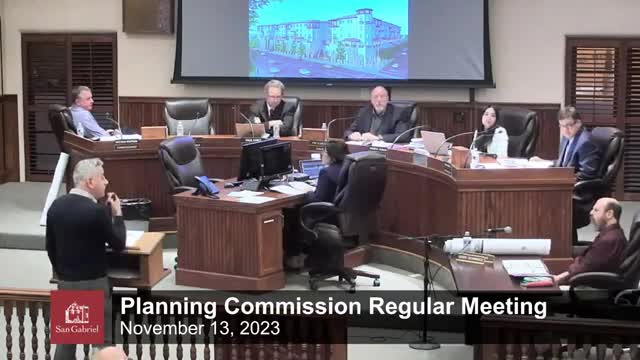City commissioners demand more low income units in proposed housing development
November 14, 2023 | San Gabriel, Yuba County, California
This article was created by AI summarizing key points discussed. AI makes mistakes, so for full details and context, please refer to the video of the full meeting. Please report any errors so we can fix them. Report an error »

In the heart of San Gabriel, city officials gathered for a Planning Commission meeting that sparked a vital discussion about housing and community needs. As the evening unfolded, the focus turned to a proposed development project that promises to reshape the local landscape, but not without raising significant concerns among commissioners and residents alike.
The project, which aims to increase the number of residential units, has been met with mixed reactions. While the developers presented plans for 225 units, a notable increase from previous proposals, the allocation of affordable housing units became a central point of contention. Currently, only 8% of the proposed units are designated as moderate income, a figure that some commissioners deemed insufficient given the community's demographics. With 58% of San Gabriel's residents classified as low income, the call for more affordable housing options resonated strongly throughout the meeting.
Commissioner concerns were palpable as they questioned the project's reliance on moderate income classifications, which require a family of four to earn nearly $120,000 to qualify. This figure starkly contrasts with the financial realities faced by many residents, prompting calls for a reassessment of the project's affordability metrics. "The majority of those units are not going to be affordable to the vast majority of our residents," one commissioner remarked, emphasizing the need for a more equitable distribution of low-income units.
The developers, acknowledging the feedback, expressed their commitment to exploring options that could enhance the project's affordability. They highlighted the challenges of balancing financial viability with community needs, noting that previous iterations of the project had included a higher percentage of affordable units. However, the shift to a development agreement instead of utilizing density bonuses raised eyebrows, as it suggested a potential compromise on the community's housing needs.
As discussions continued, the importance of integrating essential services into the development emerged as another critical theme. Commissioners advocated for the inclusion of amenities that would cater to the daily needs of residents, fostering a sense of community and enhancing the overall living experience. The vision of a vibrant neighborhood, complete with accessible services, underscored the meeting's overarching goal: to create a sustainable and inclusive environment for all San Gabriel residents.
As the meeting drew to a close, the path forward remained uncertain. The developers were urged to reconsider their approach to affordable housing, while city officials grappled with the pressing need to ensure that new developments truly reflect the needs of the community. With the stakes high and the future of San Gabriel's housing landscape hanging in the balance, the dialogue initiated at this meeting will undoubtedly shape the city's trajectory in the months to come.
The project, which aims to increase the number of residential units, has been met with mixed reactions. While the developers presented plans for 225 units, a notable increase from previous proposals, the allocation of affordable housing units became a central point of contention. Currently, only 8% of the proposed units are designated as moderate income, a figure that some commissioners deemed insufficient given the community's demographics. With 58% of San Gabriel's residents classified as low income, the call for more affordable housing options resonated strongly throughout the meeting.
Commissioner concerns were palpable as they questioned the project's reliance on moderate income classifications, which require a family of four to earn nearly $120,000 to qualify. This figure starkly contrasts with the financial realities faced by many residents, prompting calls for a reassessment of the project's affordability metrics. "The majority of those units are not going to be affordable to the vast majority of our residents," one commissioner remarked, emphasizing the need for a more equitable distribution of low-income units.
The developers, acknowledging the feedback, expressed their commitment to exploring options that could enhance the project's affordability. They highlighted the challenges of balancing financial viability with community needs, noting that previous iterations of the project had included a higher percentage of affordable units. However, the shift to a development agreement instead of utilizing density bonuses raised eyebrows, as it suggested a potential compromise on the community's housing needs.
As discussions continued, the importance of integrating essential services into the development emerged as another critical theme. Commissioners advocated for the inclusion of amenities that would cater to the daily needs of residents, fostering a sense of community and enhancing the overall living experience. The vision of a vibrant neighborhood, complete with accessible services, underscored the meeting's overarching goal: to create a sustainable and inclusive environment for all San Gabriel residents.
As the meeting drew to a close, the path forward remained uncertain. The developers were urged to reconsider their approach to affordable housing, while city officials grappled with the pressing need to ensure that new developments truly reflect the needs of the community. With the stakes high and the future of San Gabriel's housing landscape hanging in the balance, the dialogue initiated at this meeting will undoubtedly shape the city's trajectory in the months to come.
Don't Miss a Word: See the Full Meeting!
Go beyond summaries. Unlock every video, transcript, and key insight with a Founder Membership.
✓
Get instant access to full meeting videos
✓
Search and clip any phrase from complete transcripts
✓
Receive AI-powered summaries & custom alerts
✓
Enjoy lifetime, unrestricted access to government data
30-day money-back guarantee

